| Garbo - The Name
- by Annie M. - |
|
| |
|
Even after decades it is still not known where the name Garbo came from, who discovered it and what it means? Sometime, in late 1923, during a break of filming Gösta Berling saga (Sweden 1924), director Mauritz Stiller asked Greta to think about changing her name.

Mauritz Stiller asked Greta to change her name
Her Original Name |
Her orginal name was Greta Lovisa Gustafsson. Lovisa was the second name of her mother, Anna Lovisa. Many Garbo writers over the decades – misspelled the family surname.
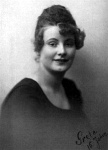
Greta with 15 years old
Gustafson with one "S" |
Many Garbo writers over the decades – misspelled the family surname. When Greta signed a standard player's contract with Svensk Filmindustri on July, 1923. She changed her last name from Gustafsson (two “s”) to Gustafson (one “s”). This was the more contemporary spelling of her last name.
Like her children, Anna Lovisa would follow Greta's lead and use the new spelling of her last name too. “As far as I know, it has always been spelled G-u-s-t-a-f-s-o-n. No one in the family (that I know of) ever spelled it any other way.” says Gray Reisfield. From now on they were all Gustafson's (with one 's' !).
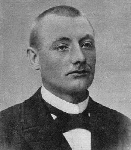 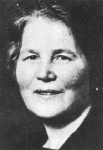
Greta's father and mother
Greta Gusta“v“son |
When Greta filled out an application for the PUB in Summer of 1920. She spelt her name as “Gustavson”. Greta decided to leave the PUB after nearly 2 years. On July 22, she had her last day in the department store and stated her reason for leaving as
“To work on Film”. She was almost 16.

Greta “Gustavson”
Garbo |
Sometime during the break of Gösta Berling saga in 1923, Mauritz Stiller asked Greta to think about changing her name. It was not the first time she had considered it – in fact, many women during this period were adopting more distinctive surnames. After centuries of Adamsdotters and Karlssons, Sweden's youth looked for a new identity.
Gustafsson was such a common name in Sweden, it filled countless pages in countless community directories; like many Swedes, the first thing Greta did was eliminate the
superfluouss
in her last name. Magda Hellberg, Greta's supervisor at PUB, recollected that the young hopeful did not think that Greta Gustafsson was refined enough for the stage: “She wanted a shorter name which could be pronounced easily in any language.”
On November 9 th , 1923, a document was drawn up and signed by Anna Gustafsson in presence of witnesses, Mona Mårtenson and Greta. This was a formal application to the Ministry of the Interior requesting permission for her daughter to adopt the legal name of Garbo. Less than a month later, on December 4th , permission was granted. On that day Greta Lovisa Gustafson died, and Greta Garbo was born. At this time Greta was working on the Gosta Berling Saga.
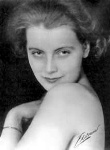
Garbo, 1923
The Name Petition |
On November 9, 1923 Anna Gustafson signed a petition asking the ministry to allow her daughter to legally change her name to Greta Garbo. Interestingly, Mona Mårtenson witnessed Greta's signing as well as her mother's. The petition was formally approved by the Ministry of Justice on December 21, 1923. By that time, Greta Garbo was back at work on Gösta Berlings saga.

The petition
Where did it come from?
There are at least nine versions of how Greta Gustafson became ‘Garbo'!
1. The Polish version |
The most absurd of which is that it derived from the Polish word wygarbowac – 'to tan leather' – an alleged twist on Stiller's desire to shape her psychic hide.The claim that her name had to be changed in order to fit on a marquee is likewise mythical: surname length didn't hinder such actors as Sixten Malmerfeldt or Jenny Öhrström-Ebbesen. Sweden had few Hollywood- style marquees anyway.
2. The Hungarian king version |
More plausible is the account by which Stiller wanted to follow up Erotikon with a similar vehicle for Tora Teje in which the heroine's name was ‘modern and elegant and international [and) says just as clearly who she is in London and Paris as in Budapest and New York'. His manuscript assistant Arthur Norden suggested ‘Mona Gabor', derived from Gabor Bethlen, the seventeenth-century Hungarian king. Stiller rather liked it but kept trying out different variations: Gabor, GabOR, Gabro ... Garbo! Tora Teje was soon abandoned, but when Greta Gustafson later fired his imagination, she had just the right Christian name to go with the surname he already had in mind.

Gabor Bethlen 3. The Etymology version |
The most romantic etymology holds that garbon was an old Norwegian word for wood nymph or forest sprite, and that Stiller chose it to signify ‘a mysterious being that comes out in the night to dance in the moonlight'.
There is, in fact, an ancient Nordic word gardbo, for ‘farm guardian', but garbo has no meaning in Swedish. It does have meaning in the Romance languages – with which Stiller and Garbo were largely unfamiliar.
4. The Italian version |
Some claim Stiller knew the Italian musical term con garbo, ‘with grace'. Garbo is a rarely used word in Italian that means a peculiar kind of grace and charm.
5. The Spanish version |
Similar to the Italian definition of the word in Spanish: ‘gracefulness, elegant carriage', often applied to bullfighters.
6. The Arthur Nordén version |
Stiller's Scenarist Arthur Nordén related that the director wanted a name that was “modern and elegant and international.” He suggested Stiller the name Gábor, which apparently delighted Stiller, who rolled it round his tongue appreciatively. He and Garbo were very sensitive to the sound of words, their imaginative stresses as much as their vocal ones.
Mercedes de Acosta remembers mentioning a Russian word, ‘toscar', to Garbo ‘who repeated it many times, pronouncing it richly and turning it, as it were, round her tongue like someone who might be speaking a beloved name'.' Stiller apparently worked the same way, trying accent and spelling variations of Gabor until he lighted on – Garbo.
7. The Mimi Pollak version |
And not to be dismissed out of hand is the claim of Mimi Pollack, who insists it was she and Greta – not Stiller – who came up with ‘Garbo'. According to Mimi Pollak, the director never mentioned the name to Greta before she went down to the Ministry of Justice to meet with Mimi's friend, Oscar Adelsson, to discuss the change.
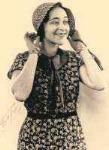
Mimi, late 1920
After looking through a stack of books and tossing around ideas with Mimi and friends, the name “Garbo” was conceived as she and Mimi walked across Norrbro Bridge on the way to the government building. It was a combination of two different surnames. “Greta thought it was wonderful. ‘Now I don't have to change the initials on my towels,' she said.” In Pollack's account, Greta herself felt Gustafson was too long and ordinary for a stage name.
She consulted Mimi, who knew a registrar at the Ministry of justice, where one day they looked through thousands of names. They liked ‘Gar-' as a beginning, she said, and their fancy was caught by the ending ‘-bo' on another name. The pseudonym is said to be a mark of power – a second chance for destiny, as well as anonymity; Coleridge said pseudonyms had to accommodate all meanings and connotations attached to them.
8. Stiller version |
Someone wrote that he derived it from the first letters of a sentence he wrote describing Greta Gustafsson: Gör alla roller berömvärt opersonligt (Plays all roles in a commendably impersonal fashion).

Mauritz
Stiller
Even if Garbo didn't actually choose hers, she at least had to approve it. Whatever its genesis and its owner's feeling about it. Stiller had a name.
9. Erica Darbo version |
The name “Garbo“, many have said, was inspired by Erica Darbo, a Norwegian operetta performer who was much applauded in Stockholm at the time.
Did you know? |
 One rumour was that the Norwegian singer Erica Darbo wanted to sue Garbo because she was using her professional name. One rumour was that the Norwegian singer Erica Darbo wanted to sue Garbo because she was using her professional name.
 Louis B. Mayer wanted her to drop the name Garbo because he thought it sounded too much like garbage, but the lady proved Louis B. Mayer wanted her to drop the name Garbo because he thought it sounded too much like garbage, but the lady proved
durable.
 Lovisa was also the first name of the Princess of Sweden (1851 – 1926). Lovisa was also the first name of the Princess of Sweden (1851 – 1926).
 Stiller and Garbo were often referred to as Pygmalion and Galatea, Beauty and the Beast or Svengali and Trilby. Stiller and Garbo were often referred to as Pygmalion and Galatea, Beauty and the Beast or Svengali and Trilby.
 Actor John Gilbert called Garbo "flicka", which means "girl" in swedish. Actor John Gilbert called Garbo "flicka", which means "girl" in swedish.
Garbos Nicknames and Pseudonyms! |
Rather than be Greta Garbo she prefers to masquerade. All pseudonyms that she has used in an effort to lose her public identity.
01. Miss Harriet Brown
02. Miss Karin Lund
03. Miss Jane Emerson
04. Miss Emily Clark
05. Miss Mary Holmquist
06. Miss Gussie Berger
07. Harry Brown
08. Mountain Boy
09. Eleanor
10. The Clown
11. GG
12. Miss G
13. G.
14. James Emerson
Her favourite was Miss Harriet Brown. Hiding behind that drab and faceless fiction, she strolled the streets of New York, Paris, London and Vienna, often stopping to browse in antique shops, where, if she asks that some piece be set aside for her (she almost never buys), she reluctantly gave her name as Miss Harriet Brown, fooling nobody, perhaps not even herself.
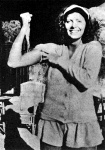
Her favourite was Miss Harriet Brown
But her desire to avoid playing the role of Greta Garbo before strangers was overpowering. She had never fully understood the part.
In later years her friends and family only called her….GG……
Her Signature |
Letters were mostly unsigned, even when they were it was usually with a pseudonym, and the subterfuge even extended to a reluctance to date anything, so envelope postmarks are the only reliable clue as to when they were written. When a signature was included, she preferred to use one of many nicknames and pseudonyms.

Harriet Brown was a favourite, so she would just sign H.B. or Harry Brown, but at other times her mood would dictate different persona's: "Mountain Boy" (M-Boy) for her secret, contradictory, but gentle masculine side; or "Eleanor" for her wistful, feminine side. They were mostly in pencil, and often on very inexpensive note-paper, where she would lightly scratch her initials- GG or just G. Her signature was a lifelong concern. More about her signature HERE!
Greta Gustafson Garbo |
During and after Gösta Berling, 1924 she kept up her studies at the Academy. Now, with increased prestige from the film, she was offered a contract as ‘leading pupil', with a thirty-dollar-a-month raise in her stipend. She signed herself ‘Greta Gustafson Garbo' this time
Greta's Nicknames as a child and teenager
1. Kata |
Kata (spell: Keta) was her childhood nickname and also in later life by her family and friends. The name derived from the way she pronounced her name when she was very small.
In 2005, Garbo's nephew Scott Reisfield said that t his was the nickname she was given as a child–after Swedish suffragette Kata Dalstrom–presumably for her strong will.
2. Gurra |
Gurra, was a nickname she was given by her friends from the Royal Dramatic Theatre Academy. The name "Gurra" is related to the name – Gustav.
Greta is or was also known as….
|
The legendary woman of mystery, Greta Garbo has baffled journalists at home and abroad. She has eluded them both in body and spirit. For more than a quarter of a century, Greta Garbo's admirers on six continents have contended with one another in trying to describe her particular spell.
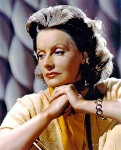
The Divine
Their prolonged and enchanting verbal skirmish has been trippingly fought on the field of superlatives. Her most famous Description. Is Garbo and The Divine (in several languages).Greta Garbo has been called “The Divine” in several languages and not a few dialects. Groping for the revealing phrase that would provide a clue to the unguessed mystery, they have had to settle for something rather commonplace, such as:
01. The Swedish Sphinx
02. The Hollywood Sphinx
03. The unapproachable Sphinx
04. The bashful Baltic beauty
05. The Divine Woman
06. The shy Valkyrie
07. The dazzling enigma
08. The Swedish Swan
09. The Arctic Mystery
10. The Face
11. The million-dollar hermit
12. The Mysterious Lady
13. The Dream Princess of Eternity
14. Garbo
15. The Sarah Bernhardt of Films
16. The New Duse
17. The Divine (in several languages)
18. The Divine Garbo
19. The Incomparable One
20. La Divine (France)
21. Die Göttliche (Germany)
22. The Incomparable One
23. The flaming icicle
24. The frozen torch
25. The First Lady of Hollywood
26. The Queen of Hollywood
27. The world's most alluring spinster
28. The face of this century
29. The sphinx of the 20th Century
30. The transparent viking girl who enchants and poisons
31. The chrystal flower
32. Sphinx of Hollywood
33. Die Märchenhafte (German for "...as in a fairytale")
34. Lady of Mystery
35. Sphinge du Nord (France)
36. Femme fantôme (France)
To some of her worshippers she is simply “poetry, sunrise and great music.” In England she has been characterized as “A superhuman symbol of The Other Woman,” and in Germany as “The supreme symbol of inscrutable tragedy.” America she has been hailed with majestic dizziness as “the mysterious, inscrutable, available but untouchable essence of the indefinable.” At the peak of her film career, when she had just turned thirty, she was “every man's harmless fantasy mistress". Whatever else Greta Garbo may represented or still represent, she is undeniably the classic symbol of womanly beauty of the 20th century.
|
| |
| |
SOURCES
Garbo - by Barry Paris
A Life Apart - by Karen Swenson
Garbo - by Robert Payne |
|